Legendary Jeongbang Waterfall
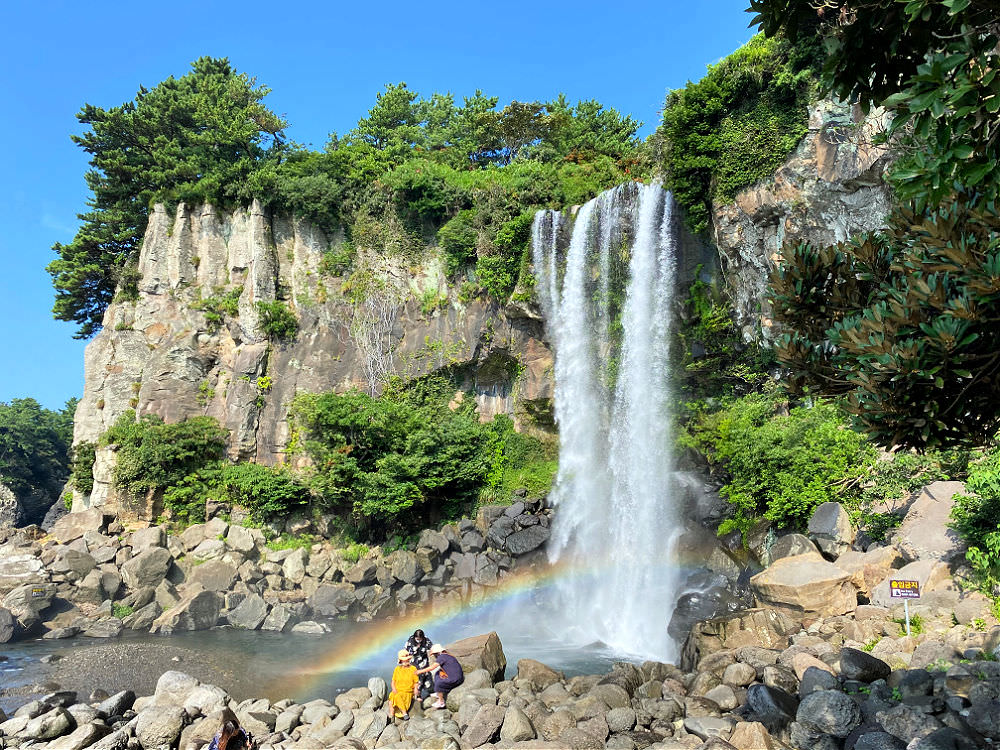 A view of Jeongbang Waterfalls being reflected by the sun and creates the rainbow
A view of Jeongbang Waterfalls being reflected by the sun and creates the rainbowIntroduction
Jeongbang Waterfall, located on the picturesque Jeju Island in South Korea, is a natural wonder that captures the hearts of visitors with its breathtaking beauty and tranquil ambiance.
As a traveler who has personally experienced the allure of Jeongbang Waterfall, I am thrilled to introduce and describe this mesmerizing attraction.
A Majestic Cascade
Jeongbang Waterfall is a majestic waterfall that cascades directly into the ocean, making it a rare and remarkable sight. With a height of approximately 23 meters (75 feet), the waterfall creates a mesmerizing display as it tumbles down from the cliff into the crystal-clear waters below. The sheer force and sound of the rushing water add to the awe-inspiring spectacle.
Scenic Natural Surroundings
Surrounded by lush greenery and dramatic coastal cliffs, Jeongbang Waterfall is situated in a stunning natural setting. The cascading waterfall, rugged rocks, and panoramic ocean views create a picturesque landscape that captivates the senses. The area is rich in natural beauty, offering visitors a serene and refreshing escape from the bustle of everyday life.
Cultural and Mythological Significance
Beyond its natural beauty, Jeongbang Waterfall holds cultural and mythological significance. According to legend, the waterfall was named after a loyal and devoted female servant named Jeongbang, who jumped off the cliff to save her master during a shipwreck. Her selfless act has been immortalized in the name of this enchanting waterfall.
Opportunities for Exploration
Jeongbang Waterfall allows visitors to explore its surroundings and immerse themselves in nature. Follow the well-maintained paths and wooden walkways to enjoy different vantage points and capture stunning waterfall photographs.
The area also provides picnic spots, rest areas, and observation decks where you can sit and appreciate the natural splendor.
Cultural Exhibitions and Amenities
Nearby Jeongbang Waterfall, you'll find a small visitor center and cultural exhibition space that provides insights into the region's history, culture, and ecology. You can learn more about the significance of the waterfall and Jeju Island's natural wonders through informative displays and exhibits.
Jeongbang Waterfall is a true gem of Jeju Island, offering a blend of natural grandeur, cultural significance, and serene surroundings. Whether you're seeking an awe-inspiring sight, a peaceful moment in nature, or a place to appreciate the legends and folklore of the island, Jeongbang Waterfall delivers an unforgettable experience.
Soak in the mesmerizing beauty of this captivating waterfall, listen to the soothing sounds of rushing water, and let the enchantment of Jeju Island wash over you.
Jeongbang Waterfall
Jeongbang Waterfall is one of the three most famous falls on Jeju Island. It is located in Seogwipo City, and its crystal water goes directly to the sea.
The height of Jeongbang is 23 meters from top to its turquoise pool. The falling water is about 8 meters wide and could be wider when there's heavy rainfall.
I was very fortunate and so delighted as I visited Jeongbang Falls for the first time after the scattered rain showers during that week.
The rainy season was already over, but I reckoned that rain keeps falling due to climate change, which is one of its effects.
The water of Jeongbang Waterfall comes from Donghong-chun Stream above it. The geological structure of Jeju Island, which is formed thousands of years ago, has created this beautiful sight.
To describe a bit, the stone walls that created the waterfall are a result of the volcanic eruption, which formed the columnar joints (or jusangjeolli cliffs) visible at the sides of the waterfall.
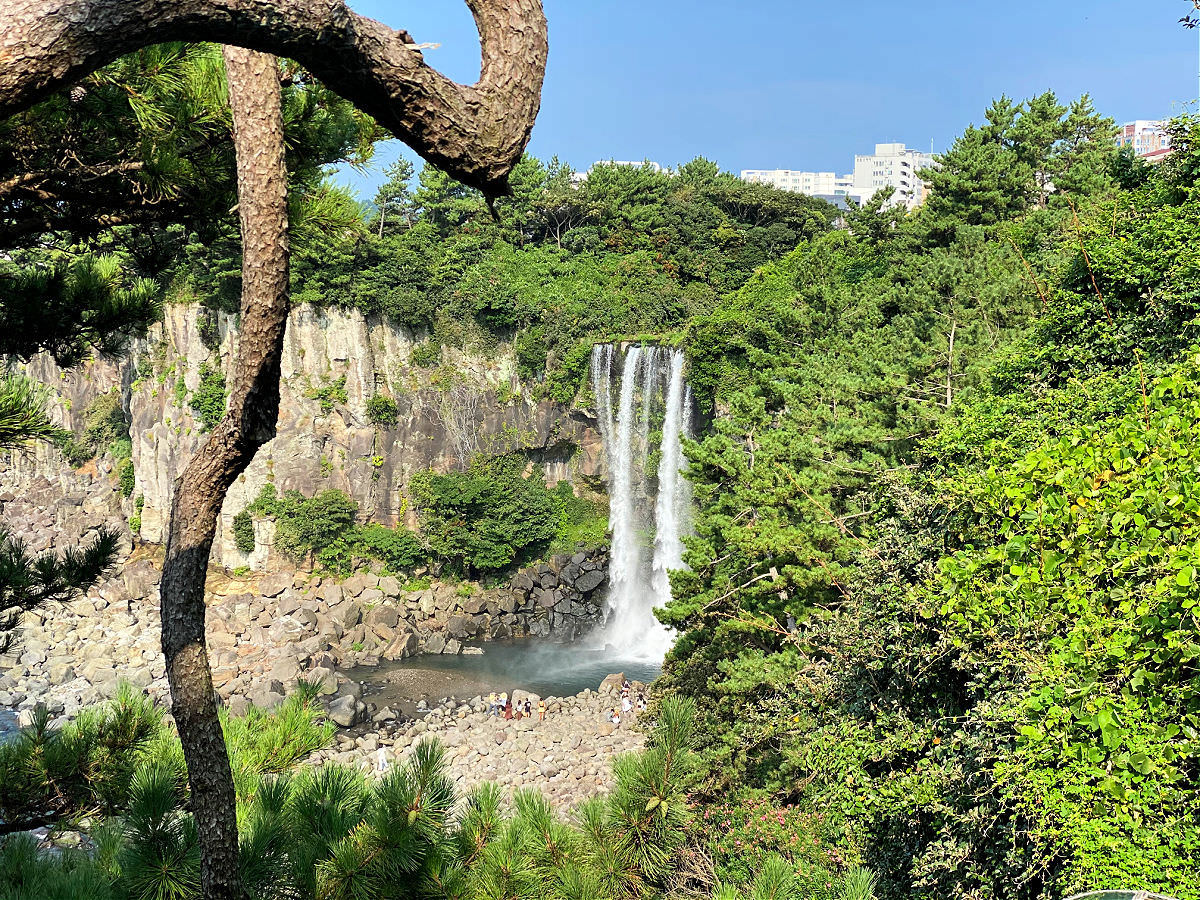 A photo I took while going down the steps leading towards Jeongbang's position
A photo I took while going down the steps leading towards Jeongbang's positionLegends of Jeongbang Waterfall
Legends are interesting stories made by locals in relation to the environment where they live.
It is the same with Jeongbang's legends. Stories told mention that people could be cured of any illnesses if they drink or bathe the water of Jeongbang Falls.
It was (or still is) believed that there was a dragon that lived in the pool, and its spirit is why its water cures. Besides that, the spirit of the dragon is believed to bring down rain during the dry season.
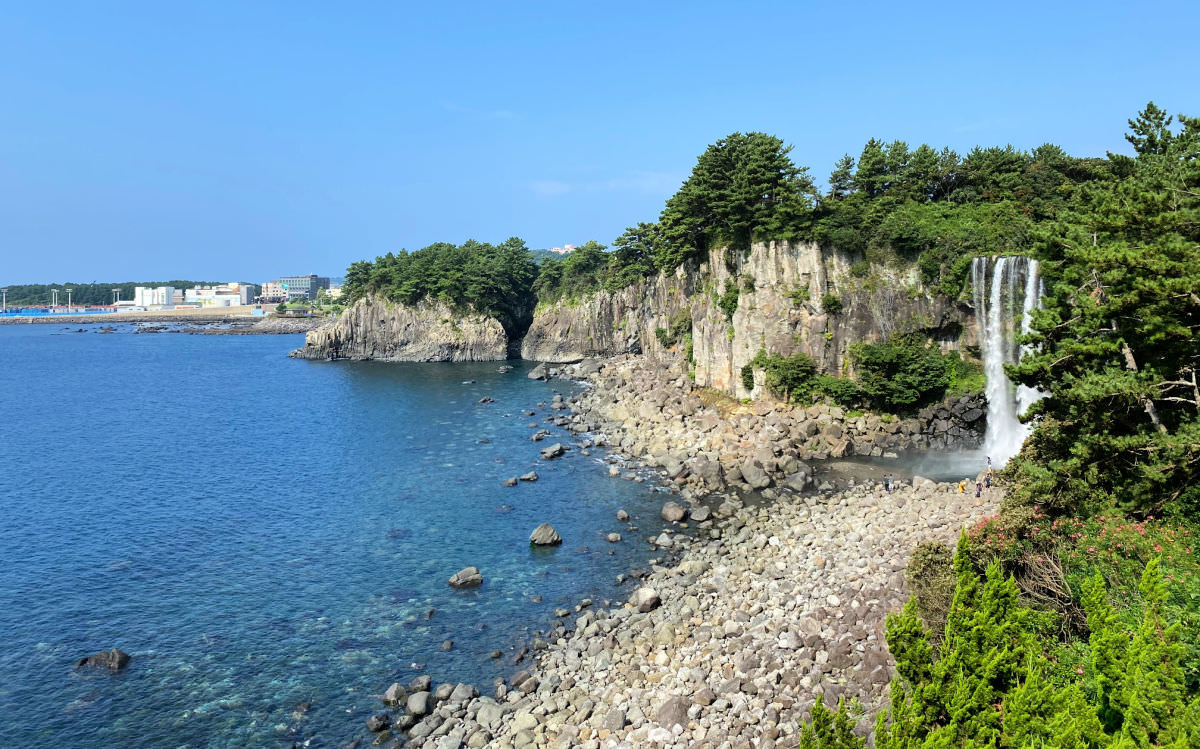 Jeongbang Fall's panoramic view
Jeongbang Fall's panoramic view
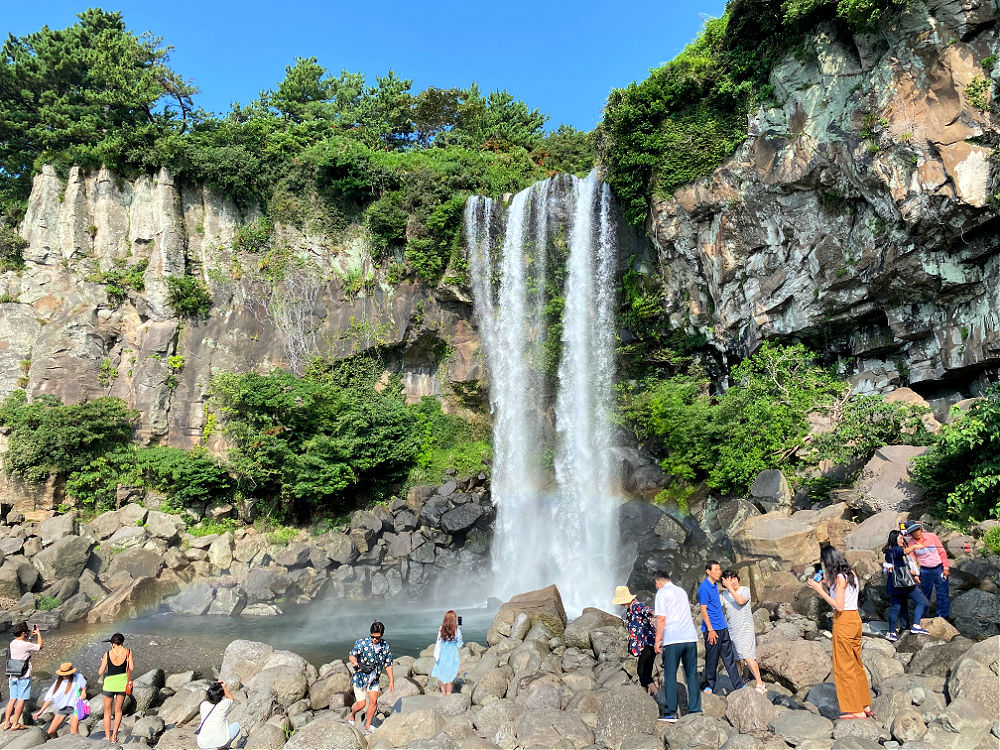 Even early in the morning, visitors start coming in to witness its beauty Even early in the morning, visitors start coming in to witness its beauty |
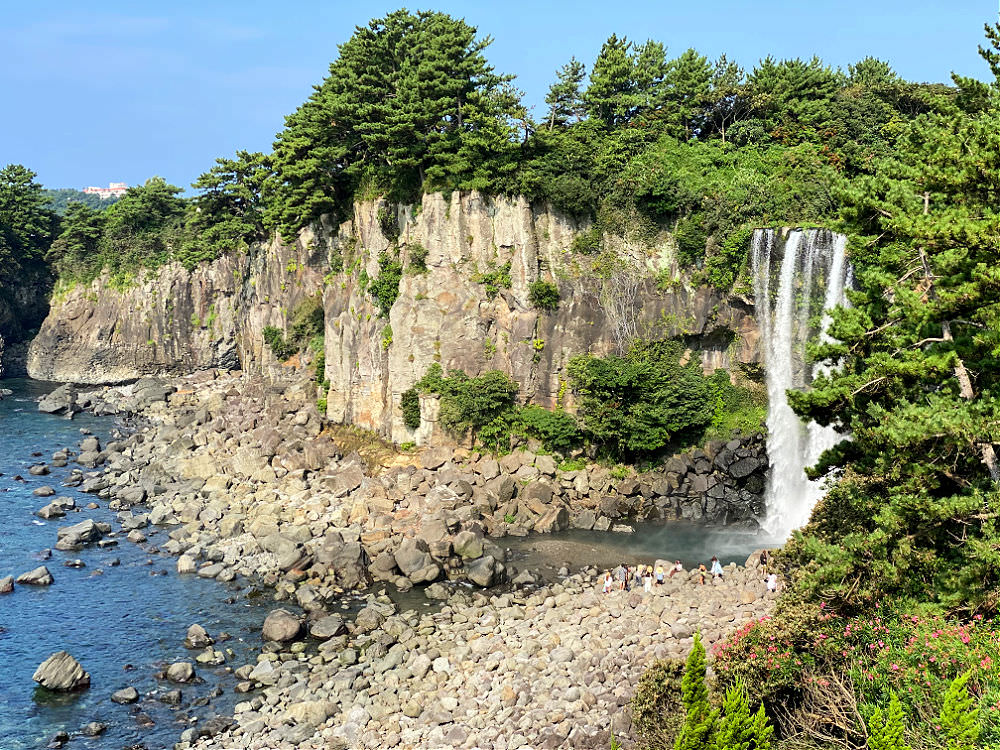 The columnar joints (lava rocks) and the Falls from the distance The columnar joints (lava rocks) and the Falls from the distance |
Inscriptions Legend
If you have traveled in many parts of Korea, you will have noticed (or already have visited similar sites) rock walls or rocks on or by the rivers carved or inscribed with Hanja (Chinese characters).
Most of such carvings or itchings are old and done by hermits and Buddhist monks. I found these carvings on the river walls and rocks nearby Buddhist temples.
For Jeongbang Waterfall, the legend says that Emperor Jin (China, 259 BC-210BC) ordered Seobul, one of the emperor's servants, to search for an elixir of life herbs from Mount Halla (or the Hallasan National Park).
The servant searched every corner of Jeju Island but found nothing. However, when Seobul discovered Jeongbang Falls, he rested there and left a carving on the rock wall, saying he has been there.
The characters say "seobul gwaji," which means Seobul was here during his quest for the elixir of youth. But it is said that the inscription is no longer visible as it is worn out due to time.
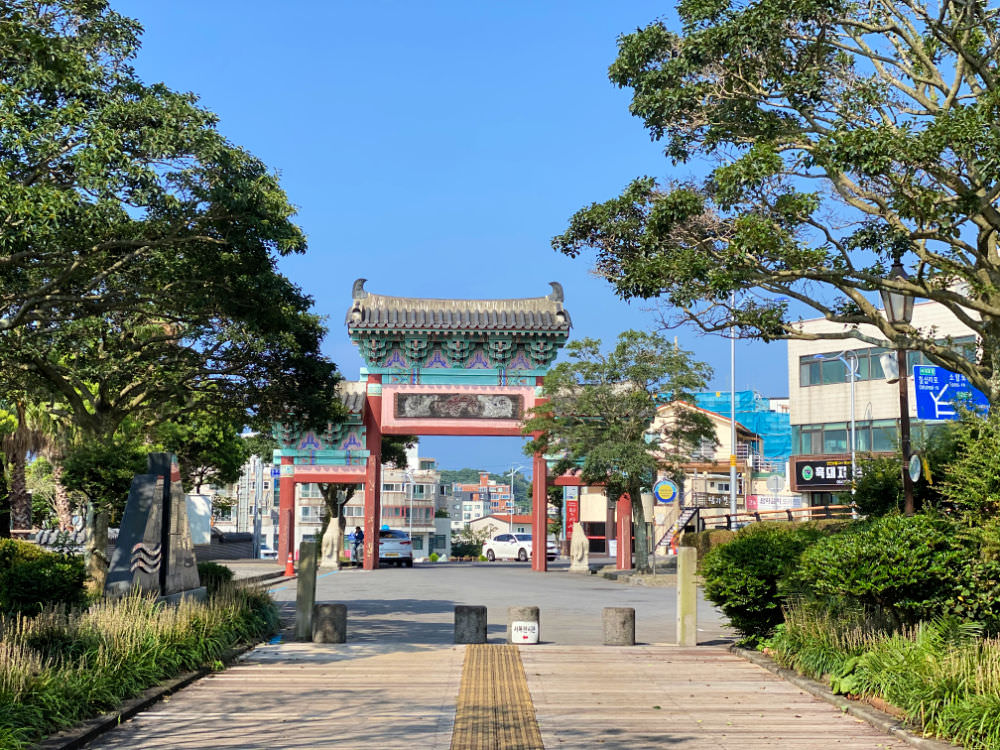 Entrance Gate towards the Waterfall area (towards my direction)
Entrance Gate towards the Waterfall area (towards my direction)Other Nearby Attractions
Jeongbang Waterfall, located on Jeju Island, offers visitors a wealth of attractions and sights to explore in its vicinity. Here are some notable attractions near Jeongbang Waterfall:
1. Cheonjiyeon Waterfall
Situated a short distance from Jeongbang Waterfall, Cheonjiyeon Waterfall is another stunning natural wonder of Jeju Island. The waterfall cascades down into a beautiful pool surrounded by lush vegetation. It is renowned for its scenic beauty, particularly during the spring when the surrounding cherry blossoms are in full bloom.
2. Seogwipo Olle Market
Immerse yourself in the vibrant local culture by visiting the Seogwipo Olle Market, located nearby. This bustling market offers a wide range of local produce, street food stalls, and traditional handicrafts. It's an ideal place to taste Jeju's unique cuisine, shop for souvenirs, and experience the lively atmosphere of a traditional Korean market.
3. Oedolgae Rock
Oedolgae Rock, also known as "Lonely Rock," is a distinctive natural rock formation that rises dramatically from the sea. Located in the Seogwipo area, near Jeongbang Waterfall, it offers magnificent views of the ocean and surrounding cliffs. Visitors can hike along the coastal trail to reach the rock and admire its imposing presence.
4. Seogwipo Maeil Olle Market
Seogwipo Maeil Olle Market is another bustling marketplace in the Seogwipo area, featuring a wide array of local produce, street food, and handmade crafts. It's a fantastic place to taste fresh seafood, sample local snacks, and engage with the friendly vendors.
5. Jeju Folk Village Museum
For a glimpse into Jeju's rich cultural heritage, consider visiting the Jeju Folk Village Museum. Located in the area, this open-air museum showcases traditional Jeju-style houses, known as "Hanok," and offers insights into the island's traditional way of life. Visitors can explore the reconstructed village, watch cultural performances, and learn about Jeju's history and customs.
6. Seogwipo Submarine
For an underwater adventure, take a submarine tour from the Seogwipo Harbor. These submarines offer the opportunity to explore the marine life and underwater landscape surrounding Jeju Island, providing a unique and memorable experience.
These attractions near Jeongbang Waterfall complement the natural beauty and cultural significance of the area, offering visitors a well-rounded experience of Jeju Island. Whether you're seeking natural wonders, local markets, or cultural immersion, the surrounding attractions provide a diverse range of experiences for every visitor to enjoy.
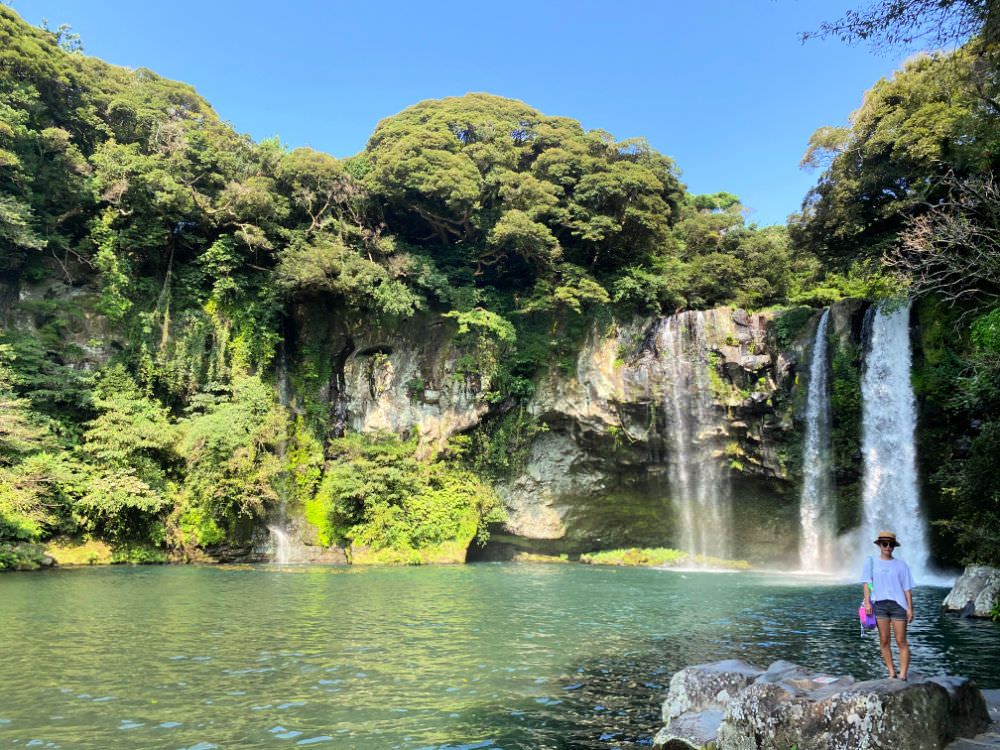 Cheonjiyeon Falls
Cheonjiyeon FallsOf course, Jeongbang Waterfall is not the only site worth seeing and spending your precious travel time.
Some of the best ones include the other waterfalls...
- Cheonjeyeon Falls
- Cheonjiyeon Falls (different falls and spelling if you can spot it)
- Jusangjeollidae or Columnar Rock Cliffs
- Yongmeori
- Sangbangsan
- And more
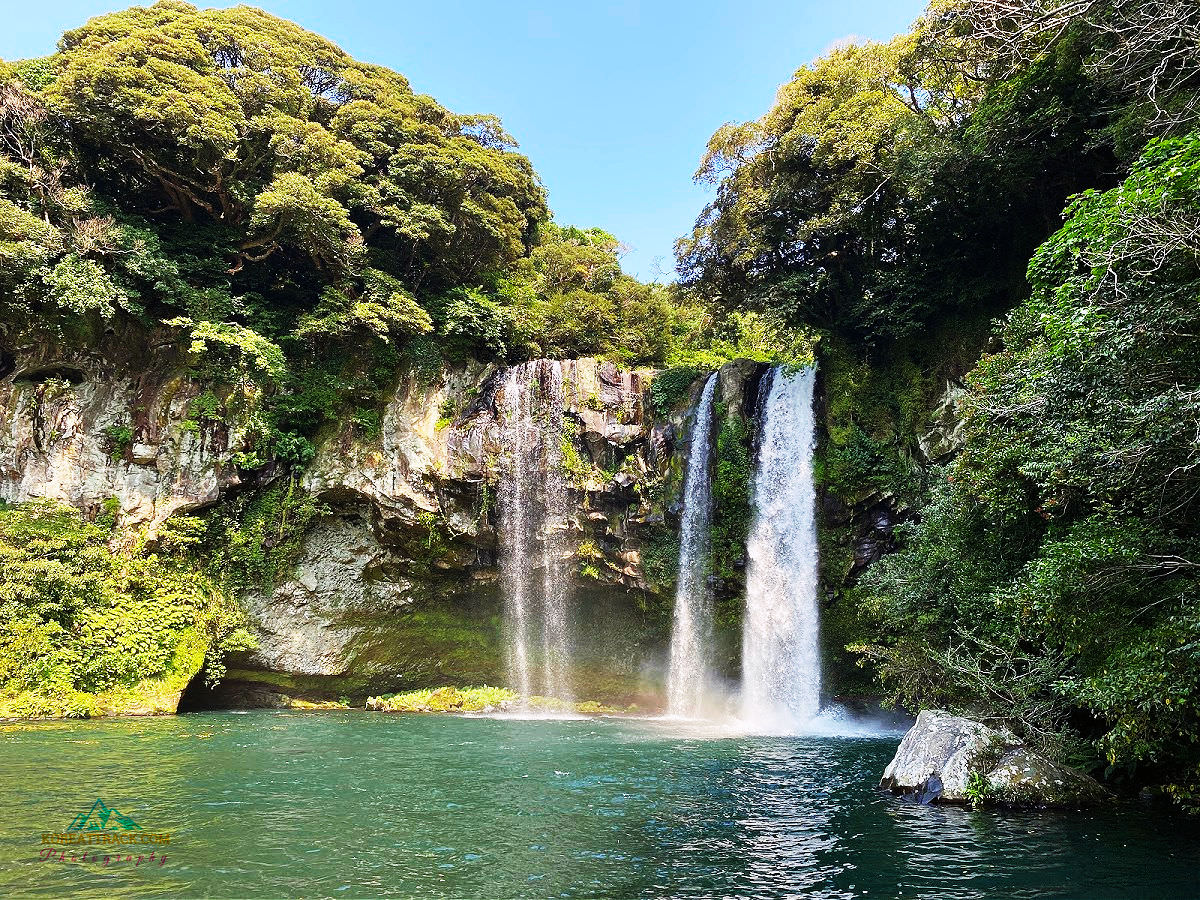 Cheonjiyeon Falls is located nearby Cheonjiyeon Falls is located nearby |
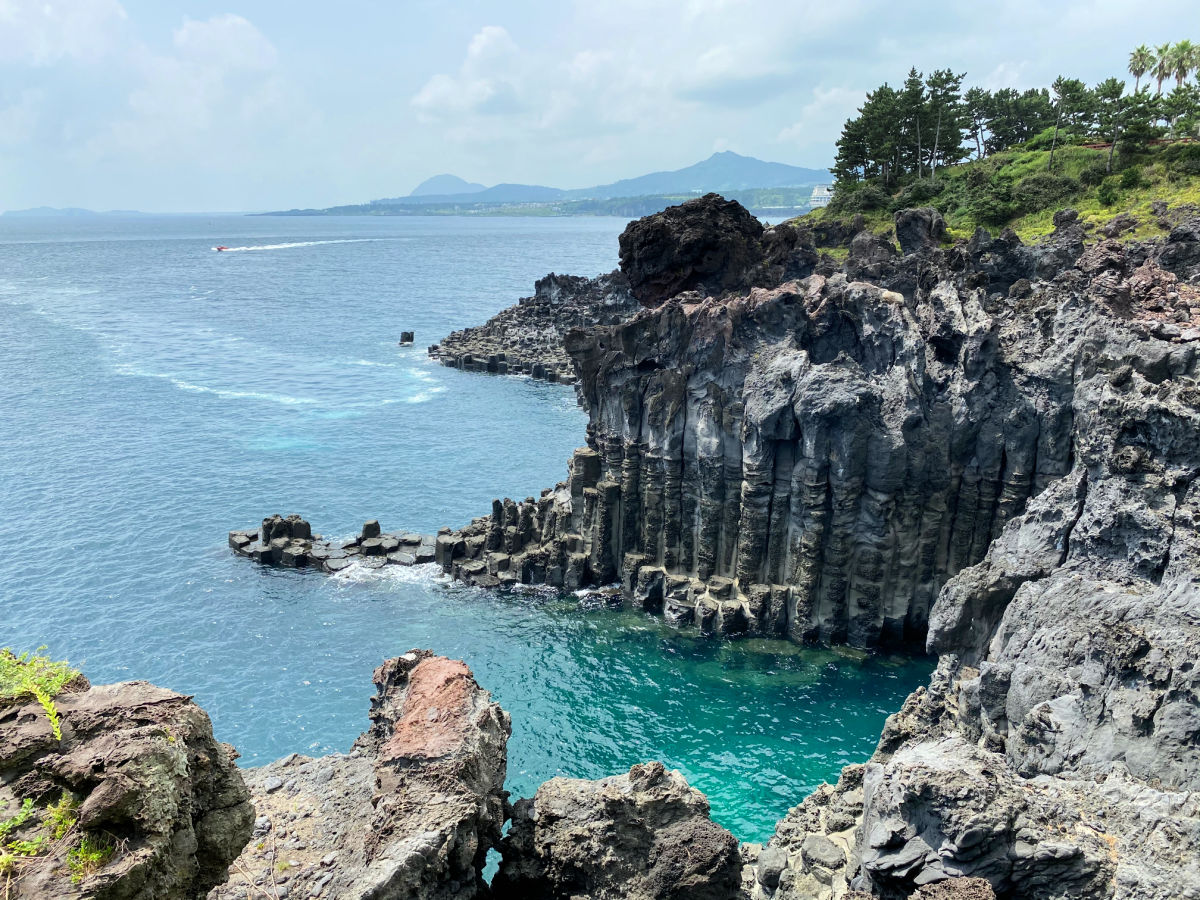 Jusangjeolli Cliffs is also nearby Jusangjeolli Cliffs is also nearby |
Getting to Jeongbang Waterfalls
Once you are in Seogwipo City, it is relatively easy to reach the falls area. You can take any public transportation, including a bus or a taxi.
Me? Since I was planning to visit more sites that day, I quickly went there taking a taxi.
But, here are some recommendations for the public transportations and possible options you can take when visiting the place.
Bus from Jeju Airport
Take a Limousine Bus from the airport that will bring you to the Paradise Hotel and Jeongbang Pokpo.
Bus from Jeju Intercity Bus Terminal
You can take any bus from this terminal to Seogwipo-si (City). It would be best if you got off at Jeju World Cup Stadium or Dongmun Rotary area.
Listen to every bus stop announcement and get ready before your bus stop by pushing the stop button.
You can also see the stadium (white and looks like an umbrella or something like that) far ahead, so it would give you a clue when to get off.
From the Stadium bus stop or Dongmun Rotary area, you can either walk for a few minutes or take a taxi (Kakao taxi or any taxi).
Other village buses also travel this area regularly.
Now, just like other travelers and visitors to Jeongbang Waterfall, I, too, enjoyed my memorable visit.
I took lots of photos and one video with my phone attached to my gimbal tool.
Thanks for reading this, and I hope you will enjoy your travel too! Keep safe!
- Home
- Jeju Island Attractions
- Jeongbang Waterfall on Jeju Island
Get Exciting Activities
Book one of our exciting activities today to experience the thrill of a lifetime! Take advantage of this opportunity and secure your spot in advance.
Hotel Map Guide
Find your affordable, accessible, and comfortable hotel in Seoul at Agoda.Com. See the hotel map below...
Hotel Booking Guide
Find affordable and amazing hotels on Agoda.com using the search box below. Book now to enjoy great discounts and save!


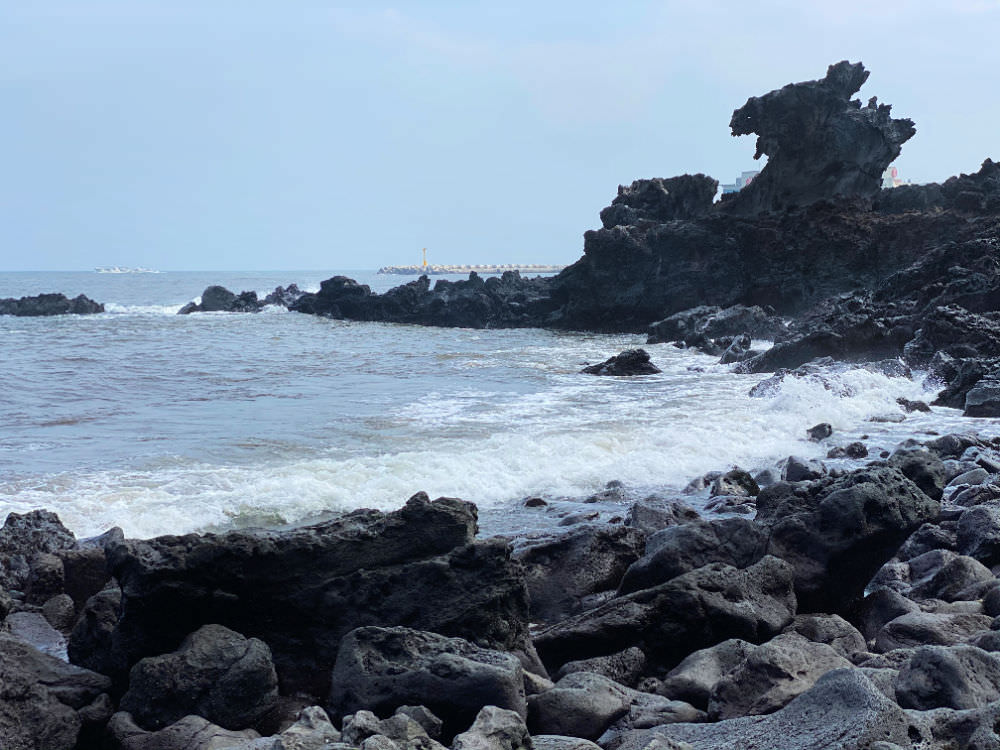




New! Comments
What do you think about this page? Leave me a comment in the box below.